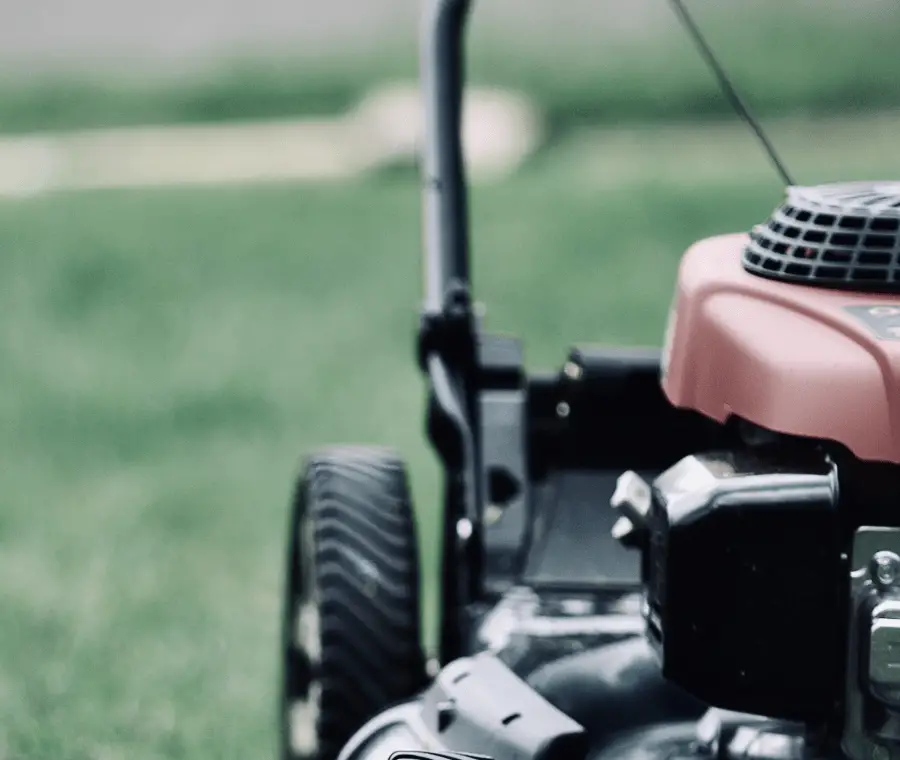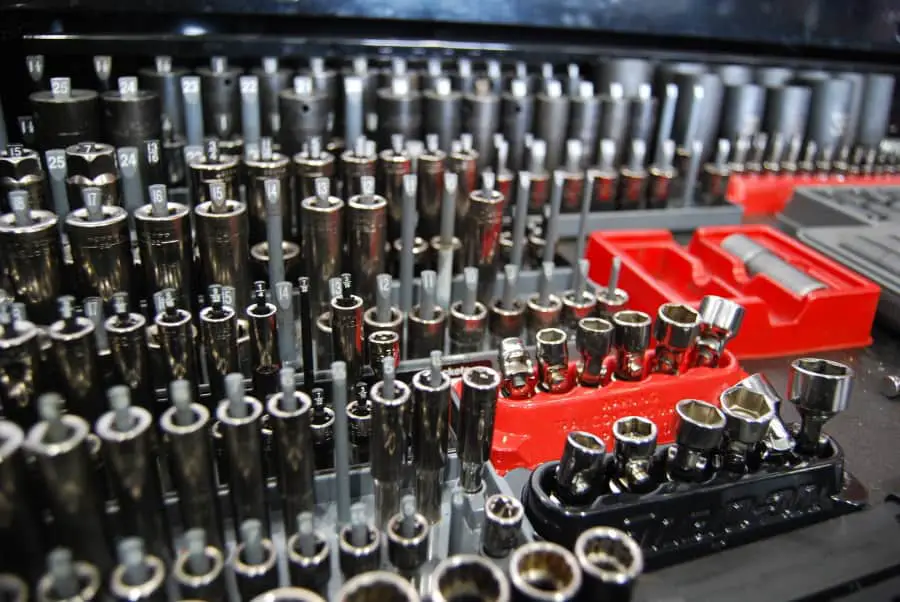Owning a lawnmower certainly has a lot more ups than downs. There is no questioning the level of convenience offered by these incredible tools, with jostling manufacturers perpetually raising the bar. However, one drawback remains as inescapable as ever…
Repairs to a mower blown head gasket can be minimized if symptoms like failure to start, smoking, loss of power, or oil leaks are caught early. These signs point to the seal created by the cork, metal, plastic, or rubber being compromised. The fix is inexpensive and will return a mower’s operation.
Yes, we’re talking about maintenance! Today we zoom in on the head gasket, one of the most overlooked parts of combustion engine lawnmowers. We discuss its role, the punishment it is likely to endure, and the signs that suggest a replacement is warranted.

Contents
Little Known Symptoms Of A Blown Lawn Mower Head Gasket
There is a good chance that people who are unfamiliar with how combustion engines work have never even heard of a “gasket”. Those that have may still be unsure of the specific role played by these little parts.
What Is A Mower Head Gasket?
Basically, a gasket is a thin piece of equipment used to seal gaps between two mated components that would, otherwise, be disjointed. In analogy terms, they are removable and flexible “mortars” that facilitate an air/liquid-tight connection between two “bricks” that do not click into place perfectly on their own.
They are only present on a gas powered engines and aren’t needed on electric battery powered ones. These regulate pressure by keeping the cylinder head from grinding into the block of the engine and causing excess friction and a reduced lifespan.
Gaskets are made from a variety of materials, ranging from cork to metal, as well as rubber, asbestos, graphite, and different plastic polymers.
Most vehicles and a lot of power tools use multiple gaskets to join various parts.
Lawnmowers are among the tools that use these sealers. Combustion engine mowers, specifically, have a special gasket known as the head gasket, which is usually made of steel. The “bricks” it joins together are the cylinder head and the engine block.
The head gasket is primarily responsible for ensuring that the internal combustion process remains just that…internal.
For a motor to start and run smoothly, the engine must be completely airtight for compression (high-pressure mixture of air and fuel) to occur as efficiently as possible.
Also, in some mower models, the head gasket prevents the mixture of engine coolant and oil. Let’s just say the mixture of these two substances is a recipe for total engine failure.
Ultimately, the head gasket is one of the key components behind your mower’s efficient operation.
Of course, like countless other parts, the head gasket is not guaranteed to work perfectly forever. Eventually, the gasket may be compromised or damaged for any number of reasons. Because the gasket is so easy to overlook, the effects of the damage can be misdiagnosed.
Having other troubles with your mower? Check out some of my other articles here to find fixes to other common problems…
- John Deere Mower Belt Keeps Coming Off.
- How Do I Make My Lawn Mower Blade Spin Faster?
- Riding Mower Won’t Move Forward Or Reverse.
Signs Of Head Gasket Failure In Your Mower
Luckily, there are a few signs that can help you identify when you have a blown head gasket on your hands. Knowing them will save you loads of time, money, and stress.
- One of the major signs of a blown gasket is a lawnmower that will not start.
This is a result of too much combustion force escaping the engine, which means poor compression. Without proper compression, the crankshaft won’t have enough momentum to keep the piston moving up and down the cylinder by itself. The mower will briefly sputter before going silent again.
- The second sign is a low power in your mower.
If, for instance, you notice the mower requiring an hour to cut the same area of grass you used to cover in 30-45 minutes, that’s a tell-tale sign of reduced power output. Your mower and blade speeds are directly tied to its engine power output. In such a case, the gasket may be blown, but not enough to prevent the mower from starting.
As you can see, compression is the big issue behind the first two signs. Therefore, carrying out a compression test should lead you to the third sign of a blown gasket:
- Low compression
Head to one of your local small engine shops and have them carry out the test with proper pressure gauges. Even some auto garages may be able to help you with a compression test for your mower.
A mower with good compression should have at least 60 pounds per square inch of pressure. If the value is lower, chances are you have a blown head gasket.
- Oil leaks are another sign worth noting, although this alone is not enough for a proper diagnosis.
A worn-out gasket may lose its ability to block off the oil coating the engine cylinders. Sometimes, this may be one of the first symptoms you notice.
- In some cases, a blown head gasket will result in excessive smoke in the exhaust.
This sign is common for mowers that are leaking oil. The smoke is caused by oil in the combustion chamber of the cylinder.
What Causes A Blown Head Gasket On A Lawn Mower?
There are a few factors that can lead to a blown head gasket, and some of them are quite preventable.
Since a mower’s head gasket is made of degradable material, excessive heat, wear and tear, along with poor construction all contribute to future problems. Some situations can be avoided by regular maintenance, but some can only be prevented by buying quality parts from the start.
Let’s look a little closer at the main causes for a blown gasket.
- Without a doubt, the number one cause is excessive engine heat.
Running an overheated motor will eventually cause the gasket to crack and rupture. If your mower uses a liquid engine coolant, make sure to routinely check the level and fill it up when needed. If you use an air-cooled mower, make sure the cooling fins are clean and clear of any obstructions.
Another way to prevent overheating is to ensure you have sufficient oil levels in the mower.
2. The second biggest cause behind a blown gasket is general wear and tear.
Unfortunately, because of cost-cutting and planned obsolescence, a few manufacturers take shortcuts with certain components, including gaskets. It is not unheard of for companies to make use of parts that do not last long after the warranty expires.
The only real way to ensure that you have quality parts that will last for many years after the warranty period is to buy a quality mower from a trusted manufacturer. This doesn’t always mean buying a well known brand name machine, but many times it does.
Will A Lawn Mower Run With A Blown Head Gasket?
This depends on the extent of the damage sustained by the head gasket if your mower will operate with a blown gasket.
As we have seen above, a gasket can be damaged enough to keep a lawnmower from starting.
If a blown gasket is still able to facilitate enough compression, the mower will run…but not at an optimum level. Continuing to use it in that condition may allow worse symptoms to creep in. In extreme cases, the engine may not start and thus will not allow it to be used for mowing at all.
If you suspect a blown gasket, get it diagnosed and replaced as soon as possible. Running your mower with a blown gasket will not do you, or the mower, any favors.
Is It Worth Repairing A Lawn Mower Head Gasket?

In most cases, repairing a lawnmower with a damaged head gasket is worth it. The gasket is a relatively cheap part, and it can be installed easily. Even if you cannot fix the mower yourself, the cost of purchasing a new gasket and hiring a professional to install it is far less than the cost of a brand-new lawnmower.
Repairing this issue will also save you from long-term fuel and oil costs. Bad compression WILL turn your mower into a ruthless gas guzzler. It also doesn’t take a rocket scientist to figure that leaky oil and smoky exhausts are warnings of serious (but avoidable) long-term costs.
The only time when the repair isn’t worth it is if the head gasket is just one of many headaches your mower gives you. This is especially true for old machines on their last legs.
Ultimately, only you (and your wallet) can determine if a fix is worth it.
How Much Does A Mower Head Gasket Repair Cost?
The main aspect to whether or not it is worth it to repair a head gasket issue is the cost associated with the repair versus just getting a new mower. If you have purchased a quality mower in the first place, the cost of a repair will be more than worth it.
The average cost to repair a blown head gasket on a mower is between $200 and $400. This includes the parts and labor, but will vary depending on location. How long the problem has been allowed to go on may determine if other repairs are needed, thus increasing the cost.
With that being said, this price range is for a professional to do the job. If you are wanting to do the repair yourself, it is a relatively straight forward process and the parts are fairly inexpensive.
The major concern is cleaning and keeping the area clean before installing the gasket.
The cost of the parts themselves are between $10 and $20 and can even be ordered from Amazon. You can check out the prices from Amazon here.
The Final Touches On Symptoms Of A Mower Blown Head Gasket…
The symptoms, fixes, and costs associated with a mower blown head gasket are fairly straight forward. It is an annoying problem to have for sure, but simple to remedy and not all that expensive. As and added bonus… if you do the repair yourself, the cost is extremely cheap.
It is important to catch the problem early though, because it usually causes high temperatures when running. This can lead to other serious problems with your mower.
Not only will high heat cost you more in future repair bills, the lower fuel efficiency will cost you more at the gas pump now. Keep an eye out for these head gasket problem symptoms and you can save yourself some time and money.
To check out some more of my articles about mower maintenance and repair, see these titles…
- John Deere Mower Belt Keeps Coming Off.
- How Do I Make My Lawn Mower Blade Spin Faster?
- Riding Mower Won’t Move Forward Or Reverse.
References
https://www.gardenguides.com/139615-signs-symptoms-blown-lawn-mower-head-gasket.html
https://www.hunker.com/13416388/signs-symptoms-of-a-blown-lawn-mower-head-gasket
